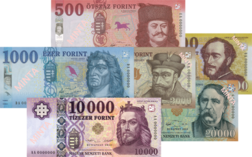
Back Hongaarse forint Afrikaans Ungarischer Forint ALS فورنت مجري Arabic فورنت مجرى ARZ Forinto húngaru AST Macarıstan forinti Azerbaijani Forint BAR Форынт Byelorussian Форынт BE-X-OLD Унгарски форинт Bulgarian
| Hungarian forint | |||
|---|---|---|---|
| Magyar forint (Hungarian) | |||
| |||
| ISO 4217 Code | HUF | ||
| User(s) | |||
| Inflation | 7.9% (January 2022) | ||
| Source | https://www.ksh.hu/ | ||
| Subunit | |||
| 1⁄100 | fillér (defunct) | ||
| Symbol | Ft | ||
| Plural | forintok (nominative only) | ||
| Coins | |||
| Freq. used | 5 Ft, 10 Ft, 20 Ft, 50 Ft, 100 Ft, 200 Ft | ||
| Banknotes | 500 Ft, 1000 Ft, 2000 Ft, 5000 Ft, 10,000 Ft, 20,000 Ft | ||
| Central bank | Hungarian National Bank | ||
| Printer | Pénzjegynyomda Zrt. Budapest | ||
| Mint | Hungarian Mint Ltd. | ||
The forint (sign Ft; code HUF) is the currency of Hungary. It was formerly divided into 100 fillér, but fillér coins are no longer in circulation. The introduction of the forint on 1 August 1946 was a crucial step in the post-World War II stabilisation of the Hungarian economy, and the currency remained relatively stable until the 1980s. Transition to a market economy in the early 1990s made the forint less valuable; inflation peaked at 35% in 1991. [1] As a member of the European Union, the long-term aim of the Hungarian government may be to replace the forint with the euro, although under the current government there is no target date for adopting the euro.[2]
- ↑ BBC News Hungary lifts last currency restrictions. 18 June 2001
- ↑ Szakacs, Gergely (2021-10-18). "Hungary's new opposition PM candidate wants stronger ties with EU". Reuters. Retrieved 2022-01-16.
